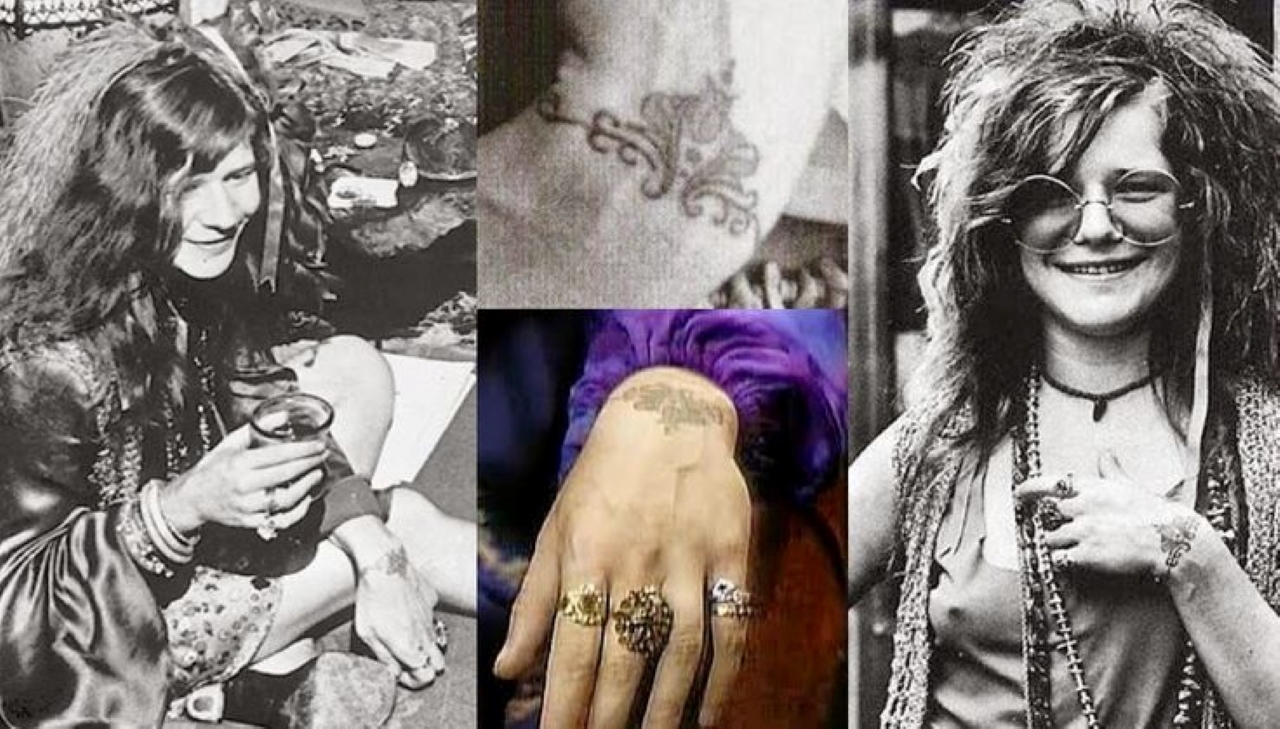The Inked Mystery: Janis Joplin’s Tattoo and the Untold Story Behind It
In the landscape of 1960s rock ‘n’ roll, Janis Joplin was more than just a voice—she was a force. Her raspy, soul-drenched vocals captured the ache and fury of a generation, while her fearless stage presence made her a symbol of liberation. But among the many layers of her complex persona lies a quieter, lesser-known detail that has intrigued fans and biographers for decades: the tattoo on her left wrist.
It wasn’t flashy. In fact, many casual fans have never noticed it. But for those who did, it begged the question: why would Janis Joplin, a woman so raw and unfiltered in her music, choose something so permanent and symbolic to etch into her skin?
The answer is as intimate and unpolished as the woman herself.

The Story Behind the Ink
The tattoo in question was a small, simple symbol—a flower-like bracelet wrapping around her wrist. Done by legendary San Francisco tattoo artist Lyle Tuttle in 1970, it was one of the first highly publicized tattoos on a female rock star.
Lyle would later say that Janis walked into his shop completely alone, without fanfare or entourage. “She didn’t want something for show,” he recalled. “She wanted something that meant something to her. Something she could carry no matter what stage she was on, no matter how loud the applause.”
Janis was deeply aware that her fame came with a cost—expectations, criticism, the weight of always being “on.” In her private writings, she often lamented feeling misunderstood or isolated despite her public bravado.
To her, the tattoo was not a rebellious act. It was an anchor.
A Mark of Control
In a rare interview just weeks before her untimely death, Janis was asked about the tattoo during a quiet moment backstage. She lifted her wrist and smiled.
“This,” she said softly, “this is the one thing nobody told me to do. No manager, no man, no fan. Just me.”
In a world that constantly tried to mold her, the tattoo became a subtle act of self-ownership. It wasn’t meant to shock or even to be seen. It was meant to remind her of who she was when the lights went out.
For women in the late ’60s, tattoos were still taboo—especially for someone in the public eye. But Janis was never one to conform. Her decision sent ripples through both the music and feminist worlds, becoming a quiet declaration of body autonomy long before it became mainstream.
The Night She Showed It
Though Janis rarely spoke of the tattoo in public, fans remember one particular moment during a concert at the Fillmore West in August 1970. It was a stripped-down set. Janis walked onto the stage wearing only a simple sleeveless dress, her hair undone and her voice raw from rehearsal.
Midway through singing “Kozmic Blues”, she raised her arm in a moment of impassioned vibrato—and for a brief second, the stage lights caught the tattoo. Someone in the front row snapped a photo. That image, later published in a long-defunct underground magazine, became one of the most sought-after collector items among Joplin devotees.
That fleeting flash of ink became something mythical.
Legacy in Ink
Janis Joplin passed away just two months later, in October 1970, at the age of 27. Her tattoo, small and quiet, remains one of the few lasting personal choices she made away from the spotlight.
In the decades since, the image of that tattoo has taken on a life of its own. Countless fans—particularly women—have chosen to replicate the design, not just as tribute, but as a statement of empowerment. Artists and biographers alike have tried to decode its full meaning, but perhaps the real truth lies in its simplicity: it was hers.
Lyle Tuttle, who also passed away in 2019, kept a framed sketch of Janis’s design in his shop for decades. “Of all the tattoos I ever did,” he once said, “that one meant the most. Not because of who she was. But because of what it meant to her.”
Why It Still Matters
Today, in an era where tattoos are common and expressions of self are encouraged, it’s easy to forget how radical Janis’s small inked bracelet truly was. It wasn’t about fashion or trend. It was a moment of quiet rebellion, a silent hymn of selfhood in a world that so often demanded she be someone else.
For a woman who sang of freedom, pain, and the unvarnished truth, it makes perfect sense. The tattoo was never just decoration—it was a song in skin.